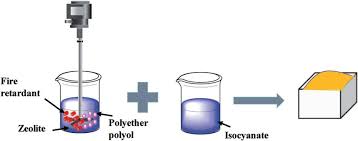
The Versatility of Rigid Foams in Various Industries
Rigid foams are a type of foam material known for their structural strength, thermal insulation properties, and versatility in a wide range of applications across different industries. These foams are created by mixing a polyol and an isocyanate, which react to form a rigid cellular structure.
Construction Industry
In the construction industry, rigid foams are commonly used as insulation materials in buildings and homes. Their high thermal resistance helps in reducing energy consumption for heating and cooling, making them an eco-friendly choice for sustainable construction practices.
Automotive Sector
Rigid foams play a crucial role in the automotive sector, where they are used for lightweighting components to improve fuel efficiency. These foams provide excellent impact resistance and sound absorption properties, enhancing the overall safety and comfort of vehicles.
Appliance Manufacturing
Appliance manufacturers utilize rigid foams for insulation purposes in refrigerators, freezers, and other household appliances. The insulating properties of these foams help maintain optimal temperature levels inside appliances while reducing energy consumption.
Marine Industry
In the marine industry, rigid foams are employed for buoyancy aids and structural components in boats and ships. Their lightweight nature combined with high strength make them ideal materials for marine applications where durability is essential.
Conclusion
Rigid foams continue to be a preferred choice across various industries due to their unique combination of strength, insulation properties, and versatility. As technology advances, these foams are being further optimized to meet the evolving needs of modern applications while contributing towards sustainability goals.
Six Essential Tips for Handling and Installing Rigid Foam Insulation Effectively
- Store rigid foam boards in a dry and cool place to prevent moisture absorption.
- Use a sharp knife or saw to cut rigid foam boards to the desired size and shape.
- Apply adhesive specially designed for foam insulation when installing rigid foams.
- Wear appropriate protective gear such as gloves and goggles when handling rigid foams.
- Seal the seams and edges of rigid foam boards with tape or sealant to improve insulation efficiency.
- Consider the R-value of the rigid foam boards to ensure proper insulation for your specific needs.
Store rigid foam boards in a dry and cool place to prevent moisture absorption.
It is important to store rigid foam boards in a dry and cool place to prevent moisture absorption. Moisture can compromise the structural integrity and insulation properties of the foam boards, leading to potential issues such as mold growth and reduced effectiveness. By storing the boards in a dry environment, you can ensure their longevity and maintain their performance for various applications in construction, automotive, appliance manufacturing, and other industries where rigid foams are commonly used.
Use a sharp knife or saw to cut rigid foam boards to the desired size and shape.
When working with rigid foam boards, it is recommended to use a sharp knife or saw to cut them to the desired size and shape. A sharp cutting tool ensures clean and precise cuts, allowing for accurate customization of the foam boards according to specific project requirements. This method not only helps in achieving a professional finish but also enhances the efficiency of working with rigid foams for various applications in industries such as construction, automotive, and manufacturing.
Apply adhesive specially designed for foam insulation when installing rigid foams.
When installing rigid foams, it is important to use an adhesive specifically designed for foam insulation. This specialized adhesive ensures a strong and durable bond between the foam and the substrate, preventing any gaps or air leaks that could compromise the insulation’s effectiveness. By using the right adhesive for rigid foams, you can ensure a secure installation that maximizes the thermal efficiency of the insulation material.
Wear appropriate protective gear such as gloves and goggles when handling rigid foams.
It is essential to prioritize safety when working with rigid foams. Always remember to wear appropriate protective gear such as gloves and goggles to protect your hands and eyes from any potential hazards during the handling of rigid foams. These safety precautions help prevent skin irritation or eye injuries, ensuring a safe working environment while dealing with these materials.
Seal the seams and edges of rigid foam boards with tape or sealant to improve insulation efficiency.
To enhance the insulation efficiency of rigid foam boards, it is advisable to seal the seams and edges using tape or sealant. By properly sealing these areas, you can prevent air leakage and heat loss, thereby maximizing the thermal performance of the foam insulation. This simple yet effective tip not only helps in maintaining a consistent indoor temperature but also contributes to energy savings by reducing the workload on heating and cooling systems.
Consider the R-value of the rigid foam boards to ensure proper insulation for your specific needs.
When working with rigid foam boards, it is essential to consider the R-value of the material to guarantee effective insulation tailored to your specific requirements. The R-value indicates the thermal resistance of the foam board, determining its ability to resist heat flow. By selecting rigid foam boards with an appropriate R-value, you can ensure that your insulation solution meets the necessary standards for energy efficiency and climate control in your particular application.
